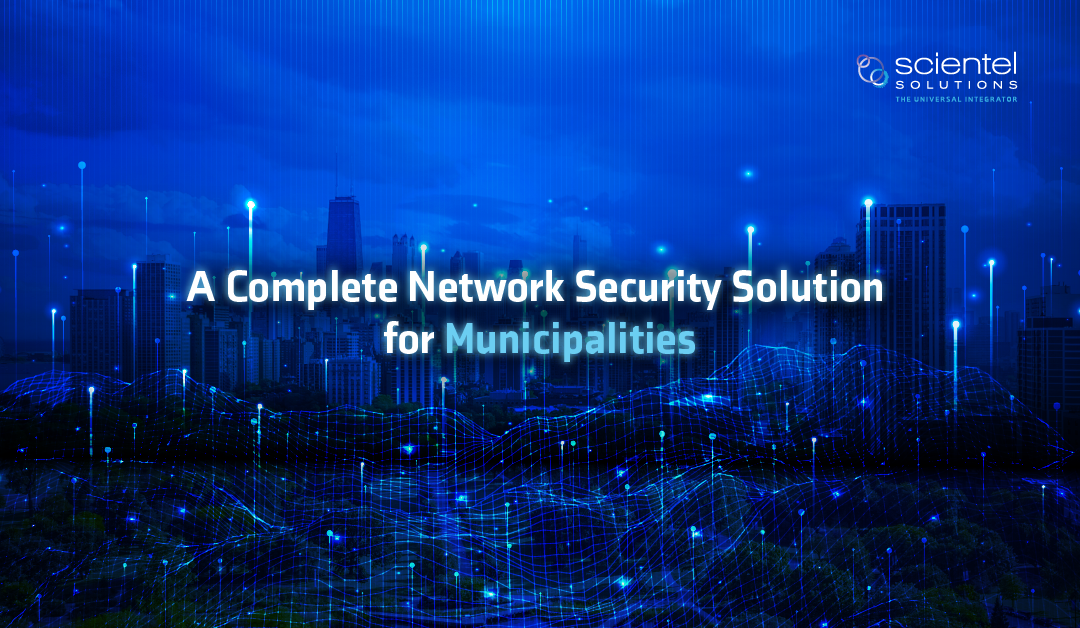by Sanket Patil, Network Engineer
One missed network intruder, one undetected ransomware attack, or one broken citizen experience risks the ability to provide vital services, bolstering economic opportunity, and improving the overall welfare of both businesses and residents. The challenge municipalities face has been a difficult balancing act. From infrastructure to public safety, the impact of IT issues or data breaches has real implications on lives and livelihoods. Every municipality has an IT team that is determined to safeguard digital interaction, while protecting the delivery of public services from advanced threats and performance issues. Having a complete network solution in place allows for improved security, collaboration, and overall increased productivity.
Despite what’s at stake, IT and security teams face constant headwinds. Advanced persistent threats and zero-day exploits put every network asset at risk for compromise. The increase in cyber-attacks and game-changing events, like the 2020 SolarWinds SUNBURST hack, are constant reminders of the razor-thin margin for error. Data sharing and open government initiatives promise innovation and new levels of collaboration while also adding new stresses on the IT team to enforce data privacy policies properly. Unprecedented levels of remote work in response to the global COVID-19 pandemic expanded the attack surface introducing new risks to the confidentiality and integrity of sensitive data. There are reporting measures to be in place for compliance with regulatory requirements including the NIST Cybersecurity Framework (CSF), HIPAA, and the FBI’s Criminal Justice Information Services (CJIS), Cybersecurity & Infrastructure Security Agency (CISA).
As targeted attacks on local governments have been on the rise, it is evident that the reliance on prevention alone is no longer sufficient to stave off sophisticated attacks or determined adversaries. A critical component for municipalities to have for their local networks is to implement network detection and response technologies which help monitor network traffic to, from, and inside your network for suspicious behavior. Employing secure firewalls and understanding the benefits of firewall security serves as a first line of defense against external threats, malware, and hackers trying to gain access to the data and systems. By providing benefits of monitoring and analyzing network traffic which leverages pre-established rules and filters to keep the systems protected. Firewalls provide an overarching benefit for promoting privacy by proactively working to keep data safe, allowing us to build an environment of privacy that the clients can trust.
An increasingly common practice is to incorporate Zero Trust in the network, which is the security framework requiring all users/devices to be authenticated, authorized, and continuously validated before being granted access to applications and data. The rise in work-from-anywhere mentality has put the spotlight on Zero Trust network access. Every time a device or user is automatically trusted, it places the organization’s data, applications, and intellectual property at risk. A few of the top priorities and benefits of Zero Trust network access include minimizing the impact of breaches or security intrusion, securing remote access, improving user experience, gaining the flexibility to provide security anywhere, leveraging cloud-delivered security, supporting enterprise application architecture evolution and to reduce capital expenditure.
For agility, cost savings, and a faster on-ramp to innovation, local governments should consider a cloud migration strategy which is a critical aspect to migrate and modernize apps effectively while enlisting intelligent automation for unlimited scalability and high availability. Cloud migration enables IT teams to enlist public cloud infrastructure so local governments can innovate without getting bogged down in managing all aspects of IT infrastructure. Some benefits of migrating to cloud include increased scalability where cloud providers offer computing resources as they are needed, enabling organizations to scale with demand, reduced cost where cloud providers manage all the underlying hardware, server maintenance, and security practices. Using cloud services, local governments can maintain a variety of distributed services across multiple clouds in regional data centers across the globe. This can dramatically decrease network latency and its effect on the end-user experience. As a result, municipality networks are seeing improved availability and performance.
The transformation and modernization of the network and security infrastructure is important to improve security, collaboration, and productivity. With the advent of newer threats that emerge across the globe daily, effective, and hardened network and security solutions are pertinent for the proper functioning of daily network activities and for smooth transactions of activities. To better align for modern networks to have performance, scale, security, and intelligence in a futureproof infrastructure, local governments should consider smart building technologies to drive impactful changes in facilities management.

